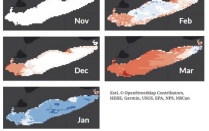The Lake Erie Snow Machine: Influences of Ice Cover on Lake-Effect Snowfall Events in Western New York
By Camryn Nelson, Embry-Riddle Aeronautical University
Advisors: Elizabeth thomas, earth sciences, University at Buffalo
Advisors: Stuart Evans, GEOGRAPHY, University at Buffalo
Project Objectives
•Lake-effect snow is a significant hazard in the Great Lakes region, and is very hard to forecast due to extremely localized impacts & specific criteria
•Knowledge gap: The general effect of ice cover is known, but not the specifics—location, thickness, progression through the snow event, etc.
•How do changes in ice cover & meteorological conditions over different parts of Lake Erie affect lake-effect snow in WNY?
Data and Results
•County snowfall data from the NWS Lake Effect Event Archive
•Recorded snow totals for various counties, correlated with ice cover
•Daily Great Lakes ice cover maps, made 20-year climatologies and monthly anomaly maps
•Data analysis in Python & ArcGIS Pro
•Results:
•Ice affects snow totals more heavily in southern counties (Chautauqua) & less in northern counties (Niagara)
•The influence of the ice varies both spatially and temporally
Significance
•Weather models do not currently evolve lake ice. Results indicate that they should
•Incorporating dynamic lake conditions into models will improve forecasting of lake-effect events
•Well-informed analysis of the conditions surrounding LES events will inform further modeling endeavors
------------------------------------------------------------------------------------------------
Center for Geological and Climate Hazards
Interdisciplinary Research Experience for Undergraduates in Atmospheric and Geological Hazards

Ice Cover on Lake-Effect Snowfall Events in Western New York